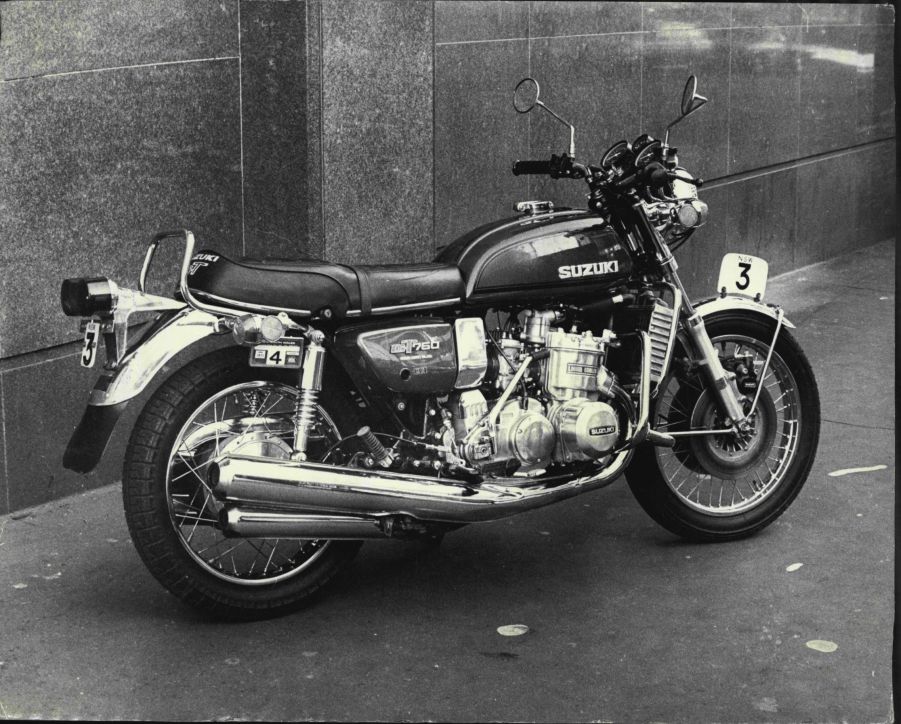
The Suzuki GT750 Was a Honda CB750-Rivaling ‘Water Buffalo’
In launching the 1969 CB750, Honda sent shockwaves throughout the motorcycling world. And it was a message no motorcycle company could ignore, especially not Honda’s Japanese rivals. Kawasaki responded with horsepower, creating the high-speed Z1 900. The Suzuki GT750, though, went with a completely different answer.
To take on the Honda CB750, the 1971-1977 Suzuki GT750 needed to be cool…liquid cool

The Honda CB750’s arrival coincided with a period of notable motorcycle technology experimentation, Silodrome reports. And at the time, Suzuki was one of the most experimental. It’s the only Japanese company to release a rotary-powered motorcycle, the RE5, for example. But before the RE5 broke ground, the Suzuki GT750 made waves of its own.
Although the Honda CB750 is a four-stroke bike, two-stroke motorcycles were a common sight in the 1960s and 1970s. And in some ways, the Suzuki GT750 resembles the two-stroke bikes Kawasaki offered at the time. For example, like the contemporary H2, the GT750 has a three-cylinder engine. However, the GT750’s 738cc two-stroke three-cylinder engine has one notable difference: liquid cooling. That made the Suzuki GT750 the first liquid-cooled Japanese production bike, RideApart explains.

Being a liquid-cooled three-cylinder two-stroke bike, the Suzuki GT750 is certainly distinct from the air-cooled, four-cylinder, four-stroke Honda CB750. But in some areas, the GT750 mirrors the CB750’s design. And Suzuki continuously tweaked it over its production run.
Initially sold with a front drum brake, in 1973 the Suzuki GT750 gained a dual-disc front setup, Motorcycle Classics notes. The following year saw the bike get upgraded carburetors, a slight power boost, and a gear position indicator. In 1975 the GT750 got revised gear ratios, larger carburetors, and more ground clearance. And in 1976, the two-stroke bike’s gearing was changed again, and it got a locking gas cap.
Whether Water Buffalo or Kettle, the Suzuki GT750 “was the anti-superbike,” Motorcyclist says—in a good way
Technically, the Suzuki GT750 was called the Le Mans in North America. But in the US it quickly earned the nickname ‘Water Buffalo’ due to its liquid cooling and 500-lb curb weight, Silodrome explains. Over in the UK, it was called the ‘Kettle,’ and Australians dubbed it ‘Water Bottle.’
Regardless of what you called it, though, the Suzuki GT750 wasn’t a superbike, Motorcyclist says. Or rather, it was “a totally different take on the superbike concept,” Brightside Media muses in the above video. While it weighs roughly the same as the Honda CB750, the GT750 is softer and doesn’t handle quite as well. Plus, it’s slower and not as sporty as its contemporary two-stroke rival, the Kawasaki H2.
However, speed and cornering clearance aren’t what draw Suzuki GT750 fans to the bike even today. Its two-stroke engine is remarkably smooth and refined. And crucially, it has plenty of low-end torque, which is ideal for long-distance touring. Also good for long-distance touring? A wide, comfy seat and well-sprung suspension, both of which the GT750 has. It’s less a Honda CB750 and more like an early two-stroke Gold Wing, which is by no means a bad thing. It’s just another way the Suzuki GT750 tread a different path compared to those early UJMs.
These vintage two-stroke UJMs still don’t cost too much
While early Suzuki GT750s had a few teething issues, overall, these two-stroke bikes are renowned for their durability, Motorcyclist says. And if you want slightly sharper handling, it’s just a suspension upgrade away.
With the industry-wide move to four-stroke engines, the Suzuki GT750 was something of a last hurrah for two-strokes. And when the GS750 arrived in 1976, the GT750 became effectively obsolete. But today, its liquid-cooled two-stroke powerplant and overall comfort have made it a desirable classic.
As a result, its market value has risen in the last few years, Hagerty notes. But it’s still more affordable than a Honda CB750. A good-to-excellent-condition example typically costs around $6000-$9000, and only pristine GT750s go for more than $10,000. Roaming on this Water Buffalo, then, won’t be too hard on your wallet.
Follow more updates from MotorBiscuit on our Facebook page.


